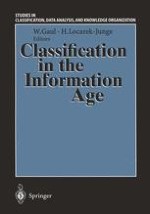1999 | Book
Classification in the Information Age
Proceedings of the 22nd Annual GfKl Conference, Dresden, March 4–6, 1998
Editors: Prof. Dr. Wolfgang Gaul, Prof. Dr. Hermann Locarek-Junge
Publisher: Springer Berlin Heidelberg
Book Series : Studies in Classification, Data Analysis, and Knowledge Organization
Included in: Professional Book Archive
